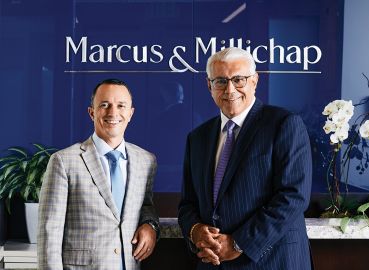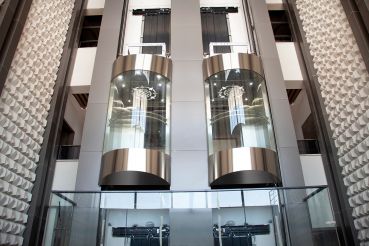Lessen CEO Jay McKee One Year After Proptech’s Biggest Acquisition
Rapid growth and operational integration followed the property services platform’s $950M deal for SMS Assist
By Philip Russo February 27, 2024 11:00 am
reprints
When Lessen acquired SMS Assist last year in the largest proptech acquisition in history, the merged companies were valued at more than $2 billion.
Thirteen months later, Jay McKee, founder and CEO of Lessen, said he might have actually underestimated the value that has come from the combined companies, which provides a property services and facilities maintenance platform for residential and retail real estate owners and vendors.
Last week, McKee spoke with PropTech Insider about how the now fully integrated company, branded as Lessen, has grown in the U.S. and Canada, how it works to maintain quality amid rapid expansion, and the benefit of being “Switzerland” in attempting to exceed the expectations of landlords, vendors and occupiers.
The interview has been edited for length and clarity.
PropTech Insider: Just over a year after Lessen and SMS Assist came together, has the deal met all your expectations?
Jay McKee: I would say it exceeded my expectations, but hindsight is always 20/20. When you take on a transaction, and let’s call it an acquisition — because Lessen did put together the financing of new equity plus the seller rolling into the new company plus some debt. It’s structured formally as an acquisition.
But when you look at it in hindsight, it was really a merger of two companies that had very complementary offerings to each other. It’s come together as a really elegant and nicely done merger and integration of two companies in the same space. But we uncovered a lot of areas that exceeded my expectations in what we could accomplish in such a short period of time.
What were those areas, specifically?
We uncovered the technology — what SMS had already built. They were much longer in the tooth; a more mature 15-year organization with significant customer concentration, production revenue, and an application that was in full-scale production. Where Lessen had more diversified customers, but was very nascent and still aspiring to build a full production platform.
So we took the tech and, over the course of last year, we went from two separate applications to one fully merged application that’s allowing us to now provide more capabilities to our customers and vendors. It’s really a two-sided marketplace now where we actually are helping our operational customers get better results for their portfolios or real estate, and, at the same time, helping our service providers become vendors or affiliates.
Specifically, the tech was a major unlock of ways to monetize a whole bunch of new revenue. Equally important, because of the transaction, we had a ton of interest from senior talent that said, “I want to come join this company.” So we kept some of the original SMS leadership team and some of the original Lessen leadership team, but I would say 80 percent of the C-suite was brought on post-transaction because they saw what we were going to do with the combination of these two companies.
It’s amazing. I never thought we could attract the type of talent we have on our management team. We have a fully integrated tech platform that is driving amazing results for our customers with zero snags during the integration.
What’s your full-time employee headcount now compared to before the acquisition?
Just about 1,200 people. I think we were 1,800 total headcount before the acquisition. Some people left, there were some redundancies, and we’ve achieved some operating efficiencies along the way. We’re actually increasing headcount versus shrinking headcount in 2024.
What was it that triggered wanting to bring these companies together, and how big a risk was it? I mean, this was an extremely large financial deal for proptech.
I think it’s still on record as the largest proptech deal ever at $950 million. I don’t know if that’s good or bad, right? I wish it was $50 million, but, unfortunately, the sellers wouldn’t have taken that.
But we saw SMS as a very big company that had great potential to add some new management and to add some new revenue, while Lessen was growing so fast it was going to be very beneficial to attach our company to this larger, more mature business. The combination of the businesses today can exceed $1 billion in annual revenue and achieve profitability for our investors.
But, given the poor investment climate at the time, how difficult was it to convince investors that the acquisition was viable and to close the deal? What was your closing argument?
I had to convince three different constituents: My original cap table of early-stage venture investors; the SMS shareholders, who were more private equity, later-stage investors; and I had to convince the debt. To get the transaction done we had to look at the market and what was happening in our industry. With interest rates changing and some of our clients doing less of the larger projects where there are multiple vendors, we knew that revenue was going to trend down. We knew SMS’s revenue of R&M — single-work order repairs and maintenance — for large portfolios, was going to go up. I had to convince those three constituents that I believed SMS was under-monetizing their $700 million of revenue, because they were.
We’ve now tapped into many areas to improve the operating margins and different aspects of what I would call our marketplace around software as a service. We’re actually seeing that half our EBITDA [earnings before interest, taxes, depreciation and amortization] creation in 2024 will be on non-take rate revenue. That’s a big, big unlock. When we looked at the transaction, we said, “We’re going to take on debt, and any time you take on debt you’re taking on more risk.” But we got the debt group to also invest a significant chunk of the capital to close the deal in equity. For every dollar of debt, they took half a dollar of equity. So they were very aligned around both a debt and equity instrument that gave me a longer runway to integrate the two companies. We had very specific goals to hit on revenue, they kept the covenants simple, and we hit those.
So, to answer your question, the risk was worth it. Here’s a data point: From 2022 to 2023, we improved the company’s EBITDA by $60 million. And we’re expecting to do that, or more, again this year. We believe we’re going to see 30 percent growth in revenue this year, while also improving our operating margins.
What was your revenue at the end of 2023, and what is it projected to be at the end of 2024?
Our revenue was about $800 million for 2023. This year we think we will be doing over $1 billion, plus or minus, of top-line gross merchandise value revenue. That’s the actual revenue that customers give us for the work that they put through our platform.
Who exactly are your clients? Are they multifamily ownership or other residential?
Fifty percent or so of our business is residential. We consider residential to be single-family residential and multifamily. And then 50 percent is scattered-site commercial. We have zero exposure to this office environment that’s hitting some triage or trauma right now. We are more scattered-site, commercial store, bank branch, retail location, shopping center, disparate assets across the 50 states.
The 50 percent of our revenue that is residential comes from large institutional REITs that own portfolios of houses. That’s multifamily companies that are looking to leverage us as a scaled national vendor. It’s really across three service areas, including repair and maintenance. That’s when you fix a toilet, water heater, air conditioning or a roof. That’s a single-ticket item. Then there’s turns, when one tenant or building occupant moves out and another one comes in. How do you get that property back to renting at its spec? And the third is when they acquire assets or portfolios. How do you renovate and get those assets to the spec level expeditiously? All those properties have to be at the same level per their brand spec. How do you do that at scale across the U.S.?
We have 30,000 and growing vendors on our platform and we have hundreds of customers. We’re doing it residentially and commercially across the United States and now in Canada, where we are now doing work for one of our largest clients, which is an expansion since the acquisition. We inherited that business from SMS, but we’ve definitely solidified it, expanded it, and made it a more prominent relationship.
How does Lessen match owner-clients to vendor users?
Everything runs through an app. For vendors, they all have to conduct their business through our app to invoice us and get paid. These vendors are quality, and we have 50 people or so in our company that are onboarding, training and recertifying vendors, while also checking insurance, making sure they’re qualified rated — all those types of things. For one of our clients, we’re doing hundreds of thousands of tickets per year at a 96 percent resident satisfaction score. We achieve that by training the vendors, telling them what the customers’ expectations are, and ensuring that it all happens through the app within the timeline.
The vendors want the work for a couple of reasons. It’s highly qualified work. It’s pre-negotiated pricing, so they know they’re going to make margin, and we pay them extra quick. We’re probably the fastest-paying company in our category. We don’t make our vendors act as our bank. We pay them before we get paid.
On the flip side, do you have a flat fee from the ownership, or do they pay you a percentage based on the work done?
Two different types. We have a cost-plus scenario with some clients, and with others it’s pre-arranged fixed pricing. It’s complicated, but once we know what the customers’ expectations are, we know we can then steer the work to the right vendors.
Your platform has a vast amount of data on it. How do you use it?
Our platform is processing just under 4 million work orders a year. We’ll do more than that in 2024. We’ve spent over $120 million — the combined companies, SMS and Lessen — on the tech. You can imagine how sophisticated and continuing to grow our tech is. We’ve invested a ton of money into a lot of the different areas of our tech, including data management and AI. We can extrapolate the data to our customers and talk about it. Some customers are managing their own people on our platform.
And then we’re managing the secondary supplemental vendors, and we can compare. We’re Switzerland. At the end of the day, all we want is good operating results, because our No. 1 goal is for our customers to spend less on operational friction, whether we’re doing it or they’re doing it.
Build to rent is apparently booming throughout the nation. Do you see that as a growing segment of your customer base?
One hundred percent. We’ve actually just closed our first — I can’t disclose who it is — full enterprise deal with a build-to-rent operator where they acquired thousands of homes. Now that they have a stabilized portfolio, it’s generally not their forte to then manage it ongoing. So we now have put this new group on our platform. You can imagine that there’s less tickets or work orders on a brand-new home versus a home that’s a 1990 vintage, but quickly into year two and three, they’re just getting a lot of wear and tear.
So we believe build to rent is a great opportunity, including just traditional homebuilders, and what can we do with them during warranty and post-warranty repairs? We’re actually discussing our platform with several major public homebuilders. How can we help them achieve operational capabilities with their residents, after the customer moves in after the warranty period?
This is somewhat speculative, but if you do your job right, and landlords aren’t too greedy, will a company like Lessen help address the affordability of housing in the U.S.?
It’s very funny that you say that. One of our customers is actually doing a study with us to see how we can actually lower the cost of our repair and maintenance. How can we get it from five tickets a year to four, for example. One of their charters is actually to not have rent increases this year and to do that through lowering their capex. They could still make the same amount of money, but they can keep rents neutral in a year.
So I don’t control the cost of their debt, control what they paid for the asset, all their operating expenses and taxes. I’m not part of that solution. But we can reduce their operating costs per ticket and lower the number of tickets, in part through call avoidance, where we have found that 20 percent of the residents who call into our AI or our app can avoid a maintenance worker visit because we can help the resident self-fix.
As you are approaching unicorn status, what do you fear for the business moving forward?
Our fear is purely execution. It’s every day. We’re getting 10,000 jobs a day right now. It’s a lot and growing. There will be 20,000 jobs in 2025. So, if we’re growing, how do you maintain quality? How do you service the customer? We love our customers. You have to be service first, customer-centric. It’s not a fear, it’s just that you can never take your foot off the gas. It’s a constant, forever business.
Philip Russo can be reached at prusso@commercialobserver.com.


